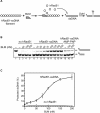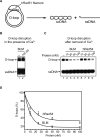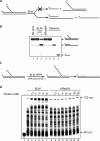Novel pro- and anti-recombination activities of the Bloom's syndrome helicase
- PMID: 18003860
- PMCID: PMC2081975
- DOI: 10.1101/gad.1609007
Novel pro- and anti-recombination activities of the Bloom's syndrome helicase
Abstract
Bloom's syndrome (BS) is an autosomal recessive disorder characterized by a strong cancer predisposition. The defining feature of BS is extreme genome instability. The gene mutated in Bloom's syndrome, BLM, encodes a DNA helicase (BLM) of the RecQ family. BLM plays a role in homologous recombination; however, its exact function remains controversial. Mutations in the BLM cause hyperrecombination between sister chromatids and homologous chromosomes, indicating an anti-recombination role. Conversely, other data show that BLM is required for recombination. It was previously shown that in vitro BLM helicase promotes disruption of recombination intermediates, regression of stalled replication forks, and dissolution of double Holliday junctions. Here, we demonstrate two novel activities of BLM: disruption of the Rad51-ssDNA (single-stranded DNA) filament, an active species that promotes homologous recombination, and stimulation of DNA repair synthesis. Using in vitro reconstitution reactions, we analyzed how different biochemical activities of BLM contribute to its functions in homologous recombination.
Figures







References
-
- Adams M.D., McVey M., Sekelsky J.J., McVey M., Sekelsky J.J., Sekelsky J.J. Drosophila BLM in double-strand break repair by synthesis-dependent strand annealing. Science. 2003;299:265–267. - PubMed
-
- Agarwal S., Tafel A.A., Kanaar R., Tafel A.A., Kanaar R., Kanaar R. DNA double-strand break repair and chromosome translocations. DNA Repair (Amst.) 2006;5:1075–1081. - PubMed
-
- Allers T., Lichten M., Lichten M. Differential timing and control of noncrossover and crossover recombination during meiosis. Cell. 2001;106:47–57. - PubMed
-
- Amitani I., Baskin R.J., Kowalczykowski S.C., Baskin R.J., Kowalczykowski S.C., Kowalczykowski S.C. Visualization of Rad54, a chromatin remodeling protein, translocating on single DNA molecules. Mol. Cell. 2006;23:143–148. - PubMed
Publication types
MeSH terms
Substances
Grants and funding
LinkOut - more resources
Full Text Sources
Medical
Research Materials
